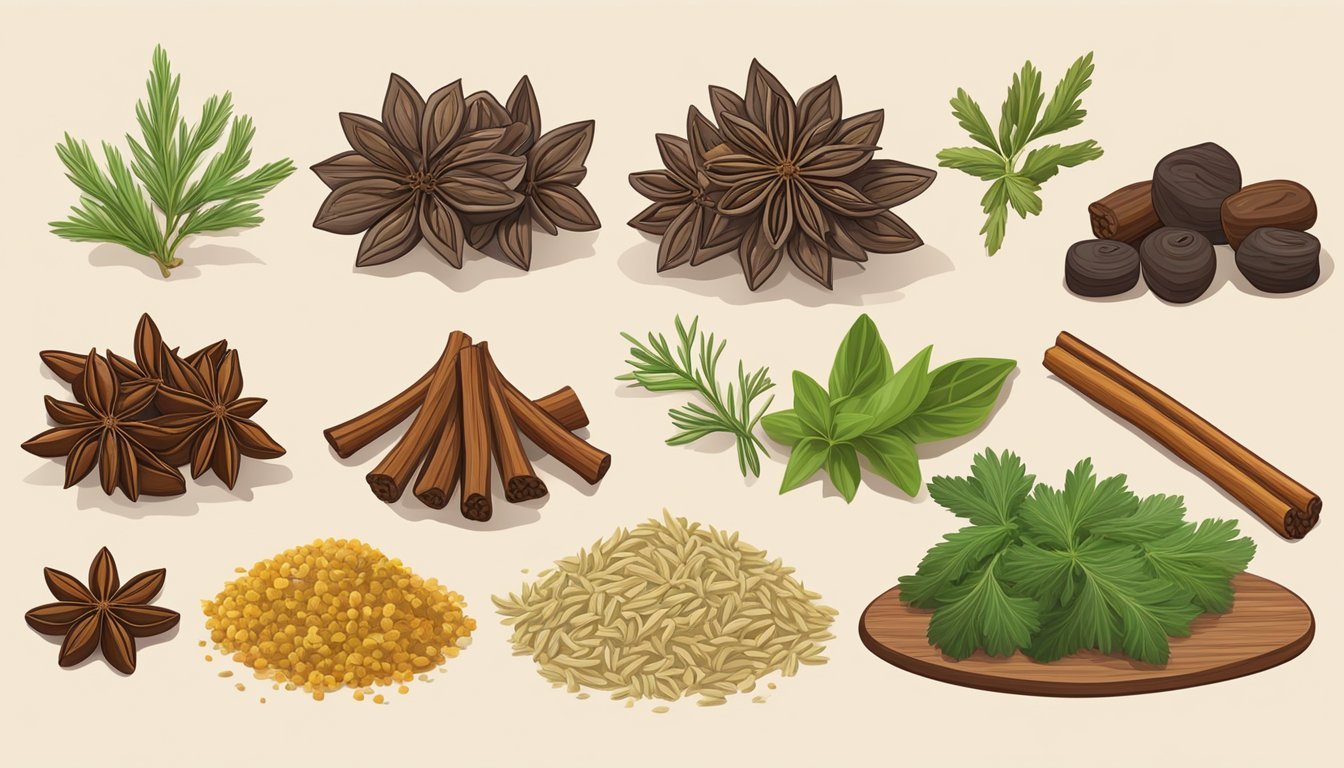Anise/Aniseed Substitutes
Top Alternatives for Your Recipes
Aniseed, also known as anise, is a highly aromatic spice that features prominently in a variety of global cuisines. Recognized for its distinctive licorice flavor, it’s a versatile ingredient used in both sweet and savory dishes. Due to its unique taste, aniseed plays a crucial role in the culinary world, from flavoring cookies and bread to spicing up stews and sausages.
However, despite its popularity, sometimes aniseed is not readily available in kitchens or grocery stores, prompting cooks to seek replacements. Finding a suitable substitute for aniseed entails matching its characteristic licorice-like taste that can transform a meal’s flavor profile. There are several alternatives to aniseed that can impart similar flavors to a dish, ensuring that the absence of aniseed does not compromise the end result.
These alternatives include fennel seeds, which share a similar flavor, lending a licorice-type taste to dishes and making them an excellent stand-in for aniseed, especially in savory recipes. Another substitute, star anise, offers a stronger version of the flavor, and therefore should be used in smaller quantities. Licorice root is another option that adds a comparable sweet and slightly spicy flavor. These substitutes not only mimic the flavor of aniseed but also contribute their own nuances to a range of recipes.
Overview of Anise
Anise, also known as aniseed, is a plant whose seeds offer a sweet, aromatic taste reminiscent of licorice. It has a long history, a variety of culinary applications, and is recognized for its health benefits.
Historical Significance
Aniseed is not just a modern culinary additive; its roots trace back to ancient civilizations. The Romans, Greeks, and Egyptians all used anise in a variety of applications, from flavoring bread to medicinal purposes. Its use over the centuries has woven it into the cultural fabric of food and health traditions across the globe.
Culinary Uses
The seeds of the anise plant are known for imparting a distinct licorice flavor to dishes. They are commonly used in a range of culinary applications, including:
Baked goods: such as bread, cookies, and cakes.
Spirits and liqueurs: like anisette and ouzo which rely on its flavor profile.
Savory dishes: where it complements meats and vegetables.
When aniseed is not available, cooks may substitute it with similar-tasting alternatives like fennel seed or star anise, though adjustments in quantities may be necessary due to differences in flavor intensity.
Health Benefits
Anise is not only valued for its unique taste but also its potential health benefits. The plant's seeds are rich in minerals and antioxidants, contributing to overall health. They have been used traditionally to treat digestive issues, with modern research investigating broader medicinal properties. The active compounds in aniseed may aid in relieving symptoms of indigestion and reducing inflammation.
Recognizing Substitutes
When seeking an anise seed substitute, understanding the factors affecting your choice and how substitutes fit different taste profiles and culinary contexts is crucial for cooking success.
Factors Affecting Substitute Choices
Availability and Intensity: A chef must consider the availability of substitutes and the intensity of flavors they bring. Star anise is richer and more robust than anise seed, so it should be used in smaller quantities. Typically, two-thirds of star anise is recommended when replacing anise seed.
Taste Profiles and Culinary Contexts In terms of flavor alignment, anise seed lends a sweet, licorice-like taste to dishes. Substitutes that share this profile include:
Fennel seeds: They offer a milder licorice flavor, making them an effective substitute in a one-to-one ratio, particularly for savory dishes.
Caraway seeds: With a woodsy, licorice hint, they are useful in bread and European cuisines.
Tarragon: Adds a distinctive anise flavor with a touch of vanilla which is more suitable for creams and lighter sauces.
Licorice root: This offers a sweet, complex profile suitable for both sweet and savory recipes.
For Ground Star Anise Substitutes: Ground star anise can be replaced by making a mix of ground anise seed with other spices such as nutmeg or cinnamon to mellow out the intensity. The blend should take into account the stronger flavor of star anise.
For Substitutes for Whole Star Anise: Options include Chinese five-spice powder, which contains star anise and complements a variety of dishes. It integrates seamlessly into recipes requiring the whole spice's aromatic presence.
Common Anise Substitutes
When seeking an alternative to anise seeds, several substitutes offer comparable flavors. These include fennel seeds, licorice root, various derivatives of star anise, and other spices with anise-like characteristics. Each substitute has a distinct profile and recommended usage.
Fennel Seed as a Substitute
Fennel seeds are an excellent stand-in for anise seeds due to their similar licorice notes. They work particularly well in savory dishes like Italian sausage and pasta sauces. As a general guideline:
Anise seeds to Fennel seeds: Use a 1:1 ratio.
Licorice Root and Licorice Flavor
Licorice root and concentrates that emulate licorice flavor can be used sparingly to replace anise seeds. They should, however, be used conservatively due to their potent taste.
Anise seeds to Licorice flavoring: Start with half the required amount and adjust to taste.
Star Anise and Its Derivatives
Star anise possesses a stronger licorice flavor and should be used judiciously as a substitute for anise seeds. Ground star anise is also an option, though it too should be utilized in smaller quantities.
Anise seeds to Star anise: Use two-thirds the amount.
Ground Star anise: Begin with half and adjust to taste.
Other Anise-like Spices
Caraway seeds and ground cloves are known for their licorice undertone and can be employed as alternatives. Blends such as Chinese five-spice powder, which includes star anise, can also impart a similar flavor profile.
Anise seeds to Caraway seeds: Match the amount or use slightly less, taste and then decide.
Ground Cloves: Use sparingly; a small pinch can replace a teaspoon of anise seeds.
Specific Applications
When substituting anise in recipes, it's important to consider how each alternative complements the dish. The goal is to maintain the integrity of the intended flavor profile while making adjustments based on the substitute's unique characteristics.
Baking with Substitutes
In baking, where anise often contributes to the complex flavors of cookies and cakes, substitutes should closely mimic the sweet and spicy notes of anise. For instance:
Fennel Seeds: Due to their natural sweetness, they are an ideal substitute in baked goods. One could use a 1:1 ratio when replacing anise seeds.
Star Anise: With a stronger flavor, less is required. For every teaspoon of anise seed, use approximately two-thirds of a teaspoon of ground star anise.
When making specific items like biscotti or pizzelle, these substitutes can deliver the licorice notes essential to the traditional taste.
Cooking Savory Dishes
Substitutes can also be tailored to savory dishes involving beef or poultry. Here, balancing flavor intensity is key:
Fennel Seeds: They complement the umami of meats and can be applied generously, as their flavor is less potent than anise. A direct 1:1 ratio is typically used.
Tarragon: With a distinct licorice flavor, chefs should incorporate tarragon sparingly to avoid overpowering the dish.
These substitutes work well in recipes like Italian sausage or poultry marinades, contributing a nuanced anise-like flavor.
Using Substitutes in Beverages
Anise is also central to the flavor profiles of various liqueurs, such as ouzo, sambuca, and absinthe. When anise is unavailable:
Star Anise: It's particularly potent and hence, should be used in smaller quantities. Grind star anise into a fine powder and use it in a slightly lesser amount than anise.
Fennel Seeds: Their milder taste requires a more direct approach. Match the amount of anise called for with an equal portion of fennel seeds to infuse the beverage with the correct flavor intensity.
Both substitutes maintain the traditional licorice flavor central to these spirited drinks.
Alternative Flavoring Agents
When cooking with anise seed and in need of a substitute, one can opt for alternatives that provide a similar flavor profile. The selection includes herbal options as well as various spice blends that can replicate the distinctive licorice-like taste characteristic of anise.
Herbal Alternatives
Among herbal substitutes, tarragon stands out for its subtle licorice notes. It can be added sparingly to desserts and creams to echo the anise seed flavor.
Tarragon:
Use in moderation due to its potent flavor.
Fresh leaves are preferred in sweet pastries and creams.
Spice Blends
Spice blends often contain a mixture of spices that can mimic the complex taste of anise seed. Chinese five-spice powder, which includes star anise, is an excellent choice for a balanced yet similar taste.
Chinese Five Spice Powder:
Comprised of star anise, cloves, Chinese cinnamon (cassia), Sichuan pepper, and fennel seeds.
Provides a well-rounded flavor with a hint of licorice.
Other spices that can be parts of blends or used standalone to mirror the taste of anise include allspice, cinnamon, and nutmeg. These should be added with care as their flavors are stronger and can easily overwhelm a dish.
Spices for Blending:
Allspice: Earthy, warm, and slightly bitter, use in small quantities.
Cinnamon (or Cassia): Sweet and woody, lends a warm spice note.
Nutmeg: Nutty and sweet but potent, so it should be used sparingly.
Shopping and Storage Tips
When shopping for anise substitutes, quality is paramount, and proper storage ensures lasting flavor. It's important to understand the characteristics of good substitutes and the techniques to preserve their potency.
Selecting Quality Substitutes
Whole Star Anise: Seek out intact, unbroken seed pods, which indicate freshness. Fragrance is a good indicator of quality; the substitutes should have a potent, sweet licorice aroma.
Anise Extract: Pure anise extract offers a concentrated flavor. Look for products without artificial additives.
Ceylon Cinnamon Powder: Opt for Ceylon over Cassia bark powder for a more subtle, sweet flavor.
Anise Oil: Ensure it is 100% pure anise oil, which is more potent than extract and thus used in smaller quantities.
Preservation and Storage Methods
Anise Substitutes:
Substitute Storage Container Environment Whole Star Anise Airtight container Cool, dark place Anise Extract Sealed bottle Away from heat Ceylon Cinnamon Glass jar Dry area Anise Oil Dark glass bottle Room temperature
Airtight Containers: Store seed pods and powders in containers with tight-fitting lids to prevent moisture and air from diminishing their flavors.
Cool, Dark Place: Keep whole star anise and cinnamon powder away from direct sunlight and heat sources, which can degrade their essential oils.
Avoid Heat: Anise extract and oil should be stored away from heat to retain their intense licorice flavor over time.
By following these guidelines, one ensures their anise substitutes maintain the utmost quality and provide robust flavor in various culinary applications.
Frequently Asked Questions
What can I use instead of anise seed?
A variety of substitutes are available for anise seed:
Star Anise: Use two-thirds of the amount. Its flavor is stronger.
Tarragon: A small quantity adds a licorice note to pastries and creams.
Fennel Seeds: They can replace anise seed in equal measures, especially in savory dishes.
Caraway Seeds: Try these for a different but comparable flavor.
Can I use anise extract as a substitute?
Yes, anise extract can replace anise seed because of its concentrated flavor. Start with a small amount and adjust to taste.
Are there any spice blends that can mimic the flavor of anise?
Chinese Five-Spice Powder, which includes star anise, is one blend that can impart a similar flavor profile.
What are suitable substitutes in baking?
When baking, substitutes like ground cinnamon or nutmeg can be used. Here’s a quick guide:
Substitute Amount to Use Ground Cinnamon Start with half the amount and adjust to taste Nutmeg Use sparingly as it is potent
These spices offer a warmth that can work well in sweet recipes requiring anise's licorice-like taste.









